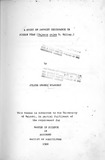| dc.description.abstract | Two experiments were conducted over two seasons. The f'irst
"'experiment (Experiment I) ran from October 1979 to March, 1980
while the second experiment (Experiment II), which was a repeat
ot experiment I,'was conducted between April and October, 1980.
Both experiments were conducted in glass-house.
Six genotypes of pigeon peas vere planted in 5 litre plastic pots
such that there were two plants per pot. Planting medium
consisted of a mixture of forest soil and cow dung manure in
the ratio of 10:1 by volume. After one month of' growth the
genotypes were subjected to four watering regimes: ,Watering daily
to container capaci t;y, watering after every 7 days to container
capacity, watering after every 14 days to container capacity, and
watering after every 21 days to container capacity. These treatments
were replicated in 5 blocks.
The results showed that drought stress had depressing effect on
plant height ,total plant dry weight, shoot dry weight, yield of
grains per plant and number of pods per plant. Effects of drought
stress on root dry weight, number of nodes per plant, number of
branches per plant and number of grains per pod were not very
clear but stress had little influence on lOO-seed weight. It
was also found that water stress favoured deposition of dry matter
in vegetative parts at the expense of pods. Of the vegetative
parts drought· stress favoured roots more than shoots with respect
to dry matter deposition.
Genotypic differences were noted in both growth and yield attributes.
Differences between seasons were remarkable in a number of cases
and were attributed to differences in temperature between the
two .seasons:
Apparently two conclusions may be made from this study:
(i) Pigeon peas in general are very resistant
to drought but early maturing genotypes are
more than late maturing ones although
the latter perform better under wet conditions.
The study of plant water relations
in pigeon peas is influenced to a large
extent by other environmental factors
such as ambient temperature and sun-shine
so that it would be difficult to isolate
the direct effects of water stress under
field conditions. | en |

